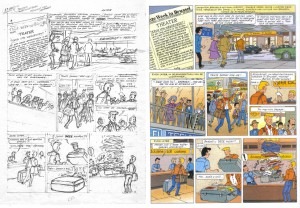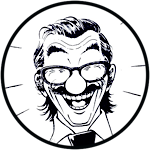Geert De Sutter sent us a few scanned pages of the preliminary sketches Bob De Moor made. The scans exist because Bob De Moor always asked that Geert De Sutter would make A3 copies of the sketches before to start working on them. The page we show you today is the first page of the “Barelli in bruisend Brussel” album.

The first thing you’ll notice is that the story is originally written in Dutch unlike the other Barelli albums which were originally written in French (and often not well translated into Dutch).
The page composition is already complete and also the characters are all placed on the page. The decors are not worked out, that will be the job for Geert De Sutter.
There are a few things though that have changed. In the first frame you see that Bob De Moor added an arrow to move the newspaper article up because the text that he wanted to add would never fit correctly in the frame. Note also that Anne Nannah is called Anna Nash here. The text itself in the news article is more or less the same although you’ll see a progressive spelling for the word ‘theater’; Bob De Moor uses ‘teater’, without the ‘h’. You also see this in the second frame where De Moor is again using the more progressive spelling, this time for the word ‘acteur’ (actor in English); he uses ‘akteur’ with a ‘k’. Note also that he had it replaced by ‘artiest’ but then reused the word ‘akteur’.
The rest of the page holds nu differences, except for the last 2 frames. You’ll see that the stickers weren’t added originally and that the objects jumping out of the luggage are a bit more diverse in the final version.
Also interesting is the text written in the left upper corner of the page. You can see the following text written by Bob De Moor: “22 Okt. verschijnt teksten geitenrijders reportage eind september”. The text itself is not really grammatically correct but it’s an interesting note, because De Moor refers to “De geitenrijders” which was the original name of the 1956 album in the Snoe & Snolleke series. The album would indeed be published in 1989, a year after this note was added via Casterman but under the title “De zondebokken”.
